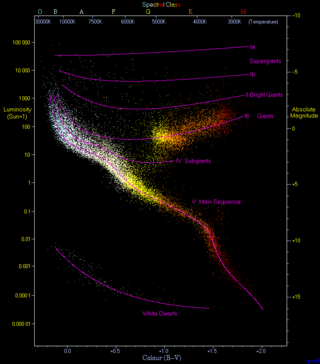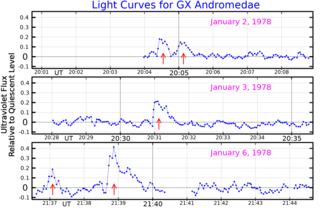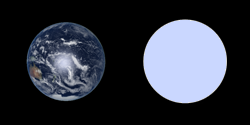The characteristic nearest star can refer to both stars:
Binary may refer to:

In astronomy, the main sequence is a classification of stars which appear on plots of stellar color versus brightness as a continuous and distinctive band. Stars on this band are known as main-sequence stars or dwarf stars, and positions of stars on and off the band are believed to indicate their physical properties, as well as their progress through several types of star life-cycles. These are the most numerous true stars in the universe and include the Sun. Color-magnitude plots are known as Hertzsprung–Russell diagrams after Ejnar Hertzsprung and Henry Norris Russell.
The following are lists of stars. Stars are astronomical objects that spend some portion of their existence generating energy through thermonuclear fusion.
The REsearch Consortium On Nearby Stars (RECONS) is an international group of astronomers founded in 1994 to investigate the stars nearest to the Solar System - with a focus on those within 10 parsecs, but as of 2012 the horizon was stretched to 25 parsecs. In part the project hopes a more accurate survey of local star systems will give a better picture of the star systems in the Galaxy as a whole.

Lacaille 9352 is a red dwarf star in the southern constellation of Piscis Austrinus. With an apparent visual magnitude of 7.34, this star is too faint to be viewed with the naked eye except possibly under excellent seeing conditions. Parallax measurements place it at a distance of about 10.74 light-years from Earth. It is the eleventh closest star system to the Solar System and is the closest star in the constellation Piscis Austrinus. The ChView simulation shows that its closest neighbour is the EZ Aquarii triple star system at about 4.1 ly away.

Ross 128 is a red dwarf in the equatorial zodiac constellation of Virgo, near β Virginis. The apparent magnitude of Ross 128 is 11.13, which is too faint to be seen with the unaided eye. Based upon parallax measurements, the distance of this star from Earth is 11.007 light-years, making it the twelfth closest stellar system to the Solar System. It was first cataloged in 1926 by American astronomer Frank Elmore Ross.

Epsilon Indi, Latinized from ε Indi, is a star system located at a distance of approximately 12 light-years from Earth in the southern constellation of Indus. The star has an orange hue and is faintly visible to the naked eye with an apparent visual magnitude of 4.83. It consists of a K-type main-sequence star, ε Indi A, and two brown dwarfs, ε Indi Ba and ε Indi Bb, in a wide orbit around it. The brown dwarfs were discovered in 2003. ε Indi Ba is an early T dwarf (T1) and ε Indi Bb a late T dwarf (T6) separated by 0.6 arcseconds, with a projected distance of 1460 AU from their primary star.
The Catalog of Nearby Habitable Systems (HabCat) is a catalogue of star systems which conceivably have habitable planets. The list was developed by scientists Jill Tarter and Margaret Turnbull under the auspices of Project Phoenix, a part of SETI.
All stars but one can be associated with an IAU constellation. IAU constellations are areas of the sky. Although there are only 88 IAU constellations, the sky is actually divided into 89 irregularly shaped boxes as the constellation Serpens is split into two separate sections, Serpens Caput to the west and Serpens Cauda to the east.

Kolob is a star or planet described in the Book of Abraham, a sacred text of the Latter Day Saint movement. Several Latter Day Saint denominations hold the Book of Abraham to have been translated from an Egyptian papyrus scroll by Joseph Smith, the founder of the movement. According to this work, Kolob is the heavenly body nearest to the throne of God. While the Book of Abraham calls Kolob a "star", it also calls planets "stars", and therefore some Latter Day Saint commentators consider Kolob a planet. The body also appears in Latter Day Saint culture, including a reference to Kolob in an LDS hymn.

Groombridge 34 is a binary star system in the northern constellation of Andromeda. It was listed as entry number 34 in A Catalogue of Circumpolar Stars, published posthumously in 1838 by British astronomer Stephen Groombridge. Based upon parallax measurements taken by the Gaia spacecraft, the system is located about 11.6 light-years from the Sun. This positions the pair among the nearest stars to the Solar System.
TZ Arietis is a red dwarf in the northern constellation of Aries. With a normal apparent visual magnitude of 12.3, it is too faint to be seen by the naked eye, although it lies relatively close to the Sun at a distance of 14.6 light-years. It is a flare star, which means it can suddenly increase in brightness for short periods of time.

GJ 1245 is a double star with components G 208-44 and G 208-45, located 15.2 light-years away in the constellation Cygnus. G 208-44 is itself a closer double star made up of two red dwarfs, while G 208-45 is also a red dwarf. GJ 1245 is the 43rd closest stellar system to the Solar System. GJ 1245 A and B are active flare stars, and the pair are collectively designated V1581 Cygni.

WD 2359-434 is a nearby degenerate star of spectral class DAP5.8, the single known component of the system, located in the constellation Phoenix, the nearest star in this constellation.
Gliese 54 is a star near the Solar System located at 25.7 light years away. It is located in the constellation of Tucana, close to the edge, almost in the neighboring Hydrus. It is below the threshold of brightness to be observable to the naked eye with an apparent magnitude of +9.80.